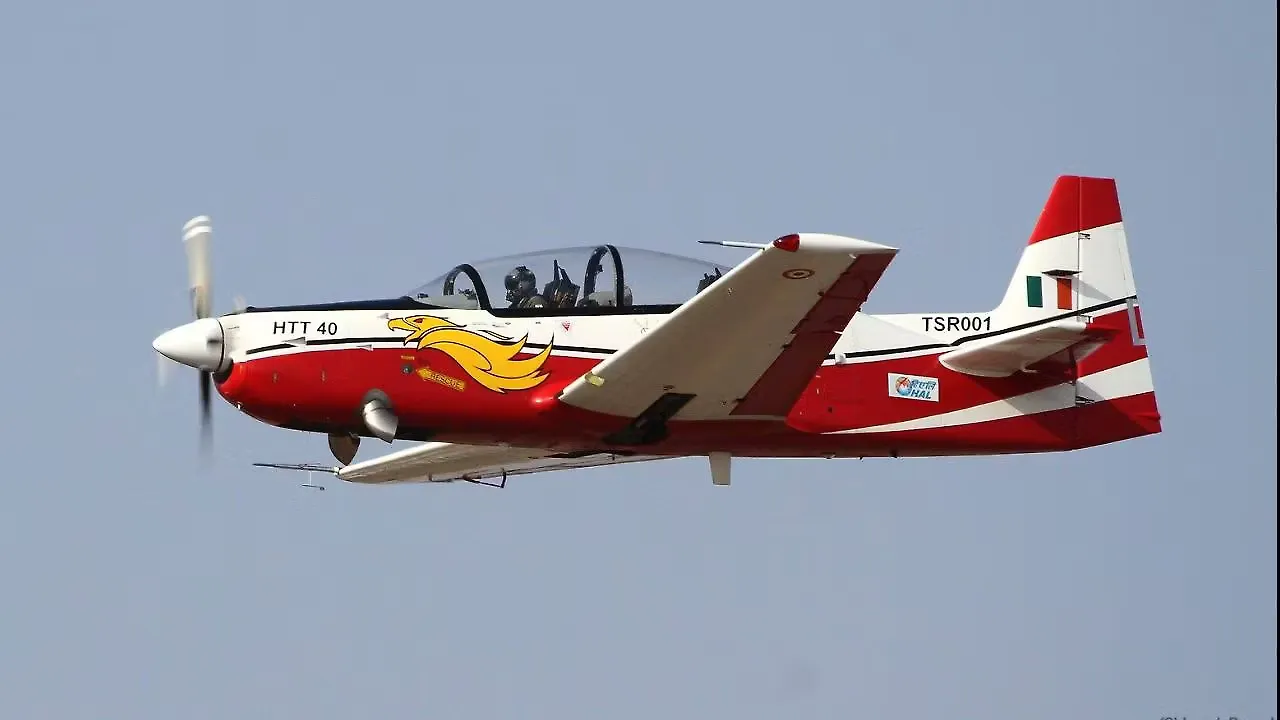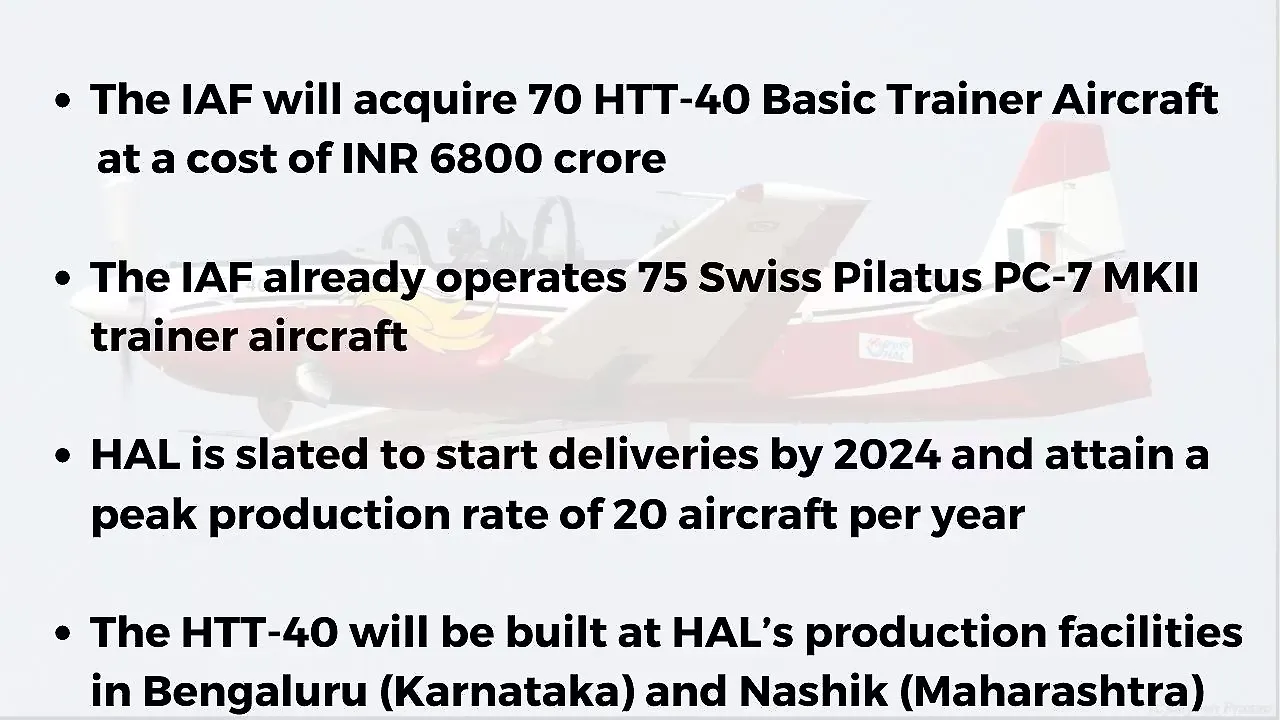
Hindustan Aeronautics Limited (HAL) will supply the Indian Air Force (IAF) with a new Basic Trainer Aircraft (BTA) in the Hindustan Turbo Trainer 40 (HTT-40). HAL was awarded an INR 6,800 crore order by the Ministry of Defence (MoD) at the recently concluded DefExpo for 70 aircraft, along with the associated infrastructure and maintenance equipment and spares.
The new aircraft will be inducted at the Air Force Academy (AFA), located in Dundigal in Telangana. The HTT-40 will join 75 Swiss Pilatus PC-7 MKII BTAs, which were ordered in May 2012, and all aircraft were delivered by November 2015. The PC-7 MKII has a lifespan of 10,000 hrs/30,000 landings. The IAF has a total sanctioned fleet of 181 BTAs, which will be met with 106 HTT-40s and 75 PC-7 MKIIs.
The IAF uses trainer aircraft for Stage I (Basic Flight Training), Stage II (Intermediate Flight Training) and Stage III (training), respectively. The IAF presently operates three different aircraft types for pilot training across the PC-7 MKII, HAL IJT-16 ‘Kiran’ and BAE Systems Hawk Mk132. The latter two are jet-powered trainers, and only the Hawk is used for Stage III training. With the induction of the HTT-40, the IAF will have two BTAs in service.

New Indigenous Trainer
HAL began the development of the new BTA in 2013 when it sanctioned company funds worth INR 177 crore to undertake the Preliminary Design Phase (PDP) and Detailed Design Phase (DDP) activities. According to a company official, HAL has invested approximately INR 600 crore in the design and development of the HTT-40, which was designed to replace the ill-fated Hindustan Piston Trainer 32 (HPT-32) ‘Deepak,’ grounded in 2009 due to flight safety risks.
It was designed by HAL’s Aircraft Research & Design Centre in Bengaluru. Over the course of the programme, three prototypes were built, including two flying prototypes and one Structural Test Specimen. The first HTT-40 prototype (PT -1) made its maiden flight in May 2016, and the developmental programme, which has progressed quickly, would likely have been completed even faster if not for the COVID-19 pandemic. The aircraft will be certified to US Federal Aviation Regulations (FAR) FAR-23 standards, built around a proven turboprop engine, and will offer good low-speed handling qualities.
In August 2020, the Defence Acquisition Council, chaired by Defence Minister Rajnath Singh, approved the procurement of 106 HTT-40 BTAs from HAL to address the IAF’s basic training requirements. It approved the initial purchase of 70 aircraft post-certification and an additional 36 aircraft once the IAF had operationalised its HTT-40 fleet in IAF. After completing the Preliminary Staff Qualitative Requirements validation trials, the IAF issued a Request for Proposal (RFP) in February 2021 at Aero India to purchase 70 aircraft with provision for 38 more. HAL obtained the RFP from the IAF within six years of the HTT-40s first flight.

HAL expects to start deliveries within two years (2024), and while initial examples will be built at Bengaluru, HAL has stated that it plans to shift production to Nashik at a later date and is targeting to produce the trainers at a peak rate of 20 per year. To quickly ramp up production, HAL is looking to outsource the manufacture of major structural components to the private sector players. “Also, at the systems level HAL has significant number of systems being sourced from various Indian partners. Some systems are sourced from HAL’s own accessories divisions, who are in turn again partnered with the Tier-3 suppliers,” the official said. The HTT-40 is slated to have an indigenous content level of 60%.
Proven Powerplant
With an order imminent, HAL entered into a contract with Honeywell worth over $100 million in July 2021 for supplying and manufacturing 88 TPE331-12B engines/kits and maintenance and support services. The ‘Manufacturing & Repair license agreement for Honeywell TPE331-12B Turboprop engine’ will manufacture these engines in India and create maintenance infrastructure and knowledge.
Speaking at the contract announcement, Eric Walters, Senior Director OE Sales, Honeywell Defence & Space, said, “The TPE331-12 family of engines has proven itself in operations all over the world, and we have committed to support and deliver engines as well as kits within the stipulated schedule to meet the requirements of the IAF. Honeywell is committed to support export of HTT-40 aircraft in coming years along with other engine programmes which are currently on radar. This contract would pave the way for future collaboration between HAL and Honeywell.”
The 950 Shaft Horsepower TPE331-12B engine is a single-shaft turboprop engine with an integral inlet and gearbox, two-stage centrifugal compressor, power turbine, gearbox, three-stage axial turbine and turbine exhaust diffuser, as well as an Engine Electronic Control unit for reliable power.
IAF has a longstanding four-decade partnership with HAL, and the new order will extend this relationship for decades. Both companies are exploring other areas such as 1MW turbo generators, manufacturing and MRO of TPE 331-10GP / 12JR engines for Dornier Do-228 variants built under license by HAL. The TPE331 was originally designed for the US military in 1959 and was Honeywell’s first turboprop engine. The TPE331 series now includes 18 engine models and 106 configurations. More than 13,000 engines have been delivered to date, accumulating over 122 million flight hours.

Basic Characteristics
Developed as an ab-initio design, the HTT-40 trainer was designed to meet the primary training requirements of the IAF. The HTT-40 will be used for basic flight training, aerobatics, instrument flying and close formation flights, in addition to undertaking secondary missions such as navigation and night flying flights.
Future armed variants could carry rockets, bombs and a gun pod and be fitted with a Head-Up Display (HUD) to aid in targeting weapons. The fully aerobatic tandem seat HTT-40 has an air-conditioned cockpit, Zero-Zero (zero speed and zero altitude) ejection seats, and modern avionics with Multifunction Displays.
The HTT-40 features all-metal construction and has a Maximum Take-Off Weight of 2.8 tonne. The BTA can achieve a top speed of 450 Km/hr and will have a maximum range of 1,000km.
Also Read:
HAL Places Orders Worth INR 52 Crore With Indian Industry
Honeywell, HAL To Jointly Make High-Power Turbogenerators
HAL-built Civil Do-228 Light Transport Aircraft Joins Alliance Air Fleet